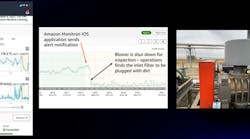Once they get educated and understand the data analytics mission and their individual assignments, everyone can get back to putting the nuts and bolts in place.
For example, Koch Ag & Energy Solutions (KAES) in Wichita, Kan., is a holding company for Koch Fertilizer LLC, Koch Energy Services LLC and Koch Methanol LLC, and several of its sites recently implemented Monitron IoT sensors from Amazon Web Services (AWS) to non-intrusively capture vibration and temperature profiles on its equipment, and relay them to KAES’ AWS cloud-computing service. The sensors are self-configuring, require not programming, and are usually glued onto devices that users want to monitor.
Dave Kroening, IT leader, and Martin Miller, data analytics leader at KAES, reported at a recent AWS re:Invent event that five KAES facilities installed 125 Monitoron sensors on less-critical, run-of-plant equipment to enable predictive maintenance and improve uptime and availability. Plant staff set up the sensors with the free Monitron app on their smartphones, and selected the ISO 20816 vibration standard option on the app, which the cloud service uses to apply the appropriate machine learning (ML) model.
Subsequent vibration and temperature signals are relayed to the cloud, where they’re analyzed and automatically identify abnormal operating states. The Monitron app also notifies plant personnel via their smartphones, allows them to review and track abnormal states at any time, and lets them enter responses to alerts received, including failure mode, failure cause and actions taken.
“We didn’t want a black box,” says Miller. “As they built these models, we wanted our operators and engineers to get the feedback to understand the equipment’s conditions and operating states. This lets them realize what a model is actually telling them and what’s driving potential failures.”
Information from the Monitron sensors and many other sensors at the KAES sites is delivered to the cloud, where AWS Lookout software and Seeq software analyze it. This enables users at KAES to more clearly understand operating conditions and apply AWS Lookout’s machine learning (ML) models to make more accurate performance predictions with far less time, labor and cost than similar efforts in the past.
“KAES uses Seeq to query process values from the AWS cloud, configure AWS Lookout for Equipment’s anomaly detection ML models, and feed updated process values into the trained models for predictions. Anomaly model scores are generated by AWS ML and operationalized in Seeq visualizations,” adds Ben Bishop principal solutions architect at Seeq. “Once data lands in the cloud, users can historize it in a variety of ways—data lakes, relational database services, columnar stores. And there’s an equally diverse number of ways to analyze it. This heterogeneity is what makes embarking on digitalization efforts challenging.”





